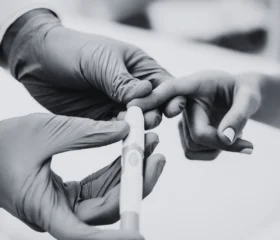Diabetes and Eyesight

The ability to see is among the most valued of all our physical senses. You may have heard that having diabetes puts you at risk for vision loss and even blindness. Why is this increased risk? The culprit is high blood glucose (sugar) which over years can damage blood vessels in every part of the body affecting the heart, kidneys, nerves, and even the eyes. Damage to the small blood vessels of the kidneys and eyes is called microvascular disease.
How does diabetes affect the eyes?
When the blood glucose stays high over time, it can damage the tiny blood vessels in the back of your eyeball in the retina. This damage can begin during prediabetes when the blood glucose is higher than usual but not high enough for an individual to be diagnosed with diabetes. Damaged blood vessels may swell or leak. New, weak blood vessels may begin to grow, causing further damage.
But there is some good news, as the CDC estimates that 90% of vision loss from diabetes can be prevented. The American Diabetes Association (ADA) also recommends two key steps to protect your eyes and vision. The first is working with your healthcare team to manage your diabetes, including reaching and keeping blood glucose, blood pressure, and blood cholesterol (lipid) goals. The second essential step to protect your vision is an annual comprehensive dilated eye exam by an ophthalmologist or an optometrist. According to the ADA 2024 standards of care for diabetes, if there is no evidence of eye disease at the eye exam and if the blood glucose (sugar) is within target, then screening every two years can be considered. Regular eye exams can help identify eye conditions so they can be treated before vision loss occurs. In addition to identifying eye disease, comprehensive eye exams can also reveal many other conditions, including diabetes, which people may not even know they have.
Diabetes eye complications
Understanding these complications is essential for early detection and prevention. Here are the main types of diabetes-related eye diseases and what you can do to protect your vision.
Diabetes-related retinopathy
Diabetes-related retinopathy is a condition where high blood glucose levels damage the small blood vessels in the retina, the light-sensitive tissue at the back of the eye. There are two stages: non-proliferative and proliferative retinopathy. In the non-proliferative stage, blood vessels weaken and leak fluid, causing swelling. Proliferative retinopathy is more severe and involves the growth of new, abnormal blood vessels that can bleed and lead to vision loss. Regular eye exams and controlling blood sugar, blood pressure, and cholesterol levels are crucial for preventing and managing retinopathy.
Researchers report that diabetes-related retinopathy occurs in 30-40% of all people living with diabetes. Across the globe, diabetes-related eye disease affects about 103 million individuals and is projected to rise to 161 million by 2045. In the United States (U.S.), it is estimated that 9.6 million people (26.43% of those with diabetes) had diabetes-related retinopathy and 1.84 million people (5.06% of those with diabetes) had vision-threatening diabetes-related retinopathy in 2021.[2] The number of people living with diabetes-related eye disease has grown rapidly due to the increasing number of people living with diabetes.
Diabetes-related macular edema
Diabetes-related macular edema (DME) occurs when fluid accumulates in the macula, the central part of the retina responsible for sharp, straight-ahead vision. This condition can cause blurry vision and may affect your ability to read, drive, and see fine details. DME often develops as a complication of diabetes-related retinopathy. Treatments for DME include anti-VEGF injections, laser therapy, and corticosteroids. Managing diabetes effectively and having regular eye check-ups can help reduce the risk of developing DME.
Cataracts
Cataracts are a common condition in which the eyes lens becomes cloudy, leading to impaired vision. People with diabetes are more likely to develop cataracts at a younger age, and the condition can progress more rapidly. Symptoms include blurry vision, difficulty with night vision, and sensitivity to light. Cataract surgery involves replacing the cloudy lens with a clear artificial one, a highly effective treatment. Keeping blood glucose levels in check can help slow the progression of cataracts.
Glaucoma
Glaucoma is a group of eye conditions that damage the optic nerve, often due to high pressure in the eye. People with diabetes are at a higher risk of developing glaucoma, which can lead to gradual vision loss and, if untreated, blindness. Open-angle glaucoma is the most common type, but people with diabetes are also at risk for neovascular glaucoma, where new blood vessels grow on the iris and block fluid drainage. Treatment options include medications, laser therapy, and surgery. Regular eye exams are vital for early detection and management of glaucoma.
What is the difference between an Ophthalmologist and an Optometrist?
Ophthalmologists are medical doctors who can treat all eye diseases and injuries, prescribe correction lenses and medications, and perform surgery. An ophthalmologist might be a generalist or specialize in certain areas, such as the retina, or in treating glaucoma. The American Academy of Ophthalmology website offers more information about ophthalmologists, educational resources regarding care for your vision, and can help you find an ophthalmologist near you.
Optometrists are not medical doctors but can conduct vision tests and diagnose, treat, and manage vision-related problems. An optometrist can prescribe corrective lenses and certain medications to treat eye problems, though the scope of practice varies by state. The American Optometric Association website offers more information about optometrists and can help you find an optometrist near you. Depending on their availability, you may rely on an optometrist for your annual eye exams, and then, if problems are detected, you may be referred to an ophthalmologist.
What should you expect in a comprehensive eye exam?
The primary method for detecting diabetes-related retinopathy, the most common eye disease, is the dilated eye exam. Expect your eye care professional to put a few drops in your eyes to dilate or enlarge your pupils. This will make your eyes sensitive to bright light and may even cause blurry vision for a few hours after the exam. To be best prepared, ask questions about how the exam will be conducted and the cost. Eye care professionals encourage you to ask questions and suggest the following:
For a routine exam, you might want to ask:
- Please explain what you found in this exam and what your recommendations are.
- Would you please provide a copy of my results with me and also share my results with my referring provider?
- How soon should my next appointment be scheduled? Can we schedule the appointment now? Will my eyes need to be dilated in the next exam? (if so, have someone drive you to the appointment.)
- What symptoms should I be aware of and watch for? If I experience these symptoms, should I contact you?
- What steps can I take to protect my vision?
If you have already experienced some vision loss:
- Given my current eyesight, is it safe for me to drive?
- Would I benefit from vision rehabilitation services?
- Would a low-vision examination be helpful for me?
- What educational resources do you recommend to help me learn more about my condition?
- What steps can I take to prevent further vision loss?
Is the eye exam cost a concern?
There are organizations and resources available which can help. Eye care professionals recommend:
- EyeCare America offers medical eye exams to qualified people in the United States, often with no out-of-pocket cost, including a Seniors Program and a Glaucoma Program. Visit the website to learn about eligibility requirements. Anyone may use the EyeCare America Drug Discount Card in English or Spanish.
- Eyes of Hope, through VSP Global, provides eye care and gift certificates for eyeglasses to children, adults, and people affected by disaster.
- Lions Club International is a nonprofit organization providing access to eye care and assistance with purchasing glasses for individuals considered low-income. Services are available for those who are blind or have limited vision through OneSight eye care centers across the country and worldwide. OneSight offers free online vision exams here. This does not replace an in-person visit with an eye care professional but can provide helpful information.
- Medicare Part B covers an annual dilated eye exam, if you are over the age of 65 with diabetes. You will pay 20% of the Medicare-approved amount and the Part B deductible.
- Mission Cataract USA provides free cataract surgeries one day a year to people of all ages who have no insurance and don’t qualify for government-provided plans.
- New Eyes offers prescription eyeglasses to children and adults at or below 2.5 times the Federal Poverty guidelines. Qualified individuals sign up with their clinician or social worker on the New Eyes website.
- Operation Sight is an organization providing free cataract surgery to United States citizens and permanent residents. To qualify, you must have a cataract diagnosis, be at or below twice the Federal Poverty Level, and be uninsured or underinsured.
Have diabetes and eye problems? Schedule an eye exam.
While diabetes-related vision loss can be prevented when detected early, less than half of people with diabetes receive routine eye exams. Having an annual eye exam takes planning and effort. However, its benefits in preventing severe vision-threatening eye disease make it well worth it. If you have not yet had an eye exam or have not had one in over a year, stop what you are doing and schedule your eye exam right now. Your vision depends on it.
References:
Wong TY, Tan TE. The Diabetic Retinopathy “Pandemic” and Evolving Global Strategies: The 2023 Friedenwald Lecture. Invest Ophthalmol Vis Sci. 2023 Dec 1;64(15):47. doi: 10.1167/iovs.64.15.47. PMID: 38153754; PMCID: PMC10756246.
Lundeen EA, Burke-Conte Z, Rein DB, et al. Prevalence of Diabetic Retinopathy in the US in 2021. JAMA Ophthalmol. 2023;141(8):747–754. doi:10.1001/jamaophthalmol.2023.2289
https://www.cdc.gov/visionhealth/basics/ced/fastfacts.htm#:~:text=90%25%20of%20blindness%20caused%20by,and%20diminished%20quality%20of%20life. Accessed April 2, 2024.
American Diabetes Association Standards of Care in Diabetes—2024. Chapter 12. Retinopathy, Neuropathy, and Foot Care. Diabetes Care. 2024;47(Supplement 1):S231-S243.
https://www.aao.org/newsroom/news-releases/detail/sixty-percent-americans-with-diabetes-skip-exams (Accessed April 3, 2024).
Written by






